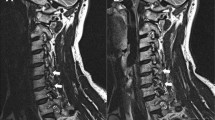Summary
Endoscopic cervical foraminotomy is increasingly used for cervical spondylotic radiculopathy (CSR), but there is great concern about radiation exposure because of the heavy dependence of this surgical method on fluoroscopy. The objective of this study was to introduce in detail an advanced surgical technique of keyhole foraminotomy via a percutaneous posterior full-endoscopic approach as a treatment for CSR and investigate its clinical outcomes. We retrospectively reviewed 33 consecutive patients with CSR who underwent keyhole foraminotomy via a percutaneous posterior full-endoscopic approach from October 2015 to April 2017. The patients’ general characteristics, including operative time, blood loss, hospital stay, complications, and recurrence, were obtained. Clinical outcomes were evaluated using the visual analogue scale (VAS) for radicular pain, the neck disability index (NDI) for functional assessment, and the modified MacNab criteria for patient satisfaction. All operations were successfully performed (mean operation time, 62 min), with no measurable blood loss or severe related complications. The mean follow-up was 25 months. The VAS and NDI scores were significantly improved as compared with those in the preoperative period (preoperative vs. final follow-up: 7.6±1.6 vs. 3.83±7.34 for VAS, P<0.01; 69.5%±10.5% vs. 17.54%±13.40% for NDI, P<0.01). Of the 33 patients, 32 (97.0%) had good-to-excellent global outcomes and all patients obtained symptomatic improvement. In conclusion, keyhole foraminotomy via a percutaneous posterior full-endoscopic approach is an efficient, safe, and feasible procedure for the treatment of CSR. Its simplified single-step blunt incision for localization appears to decrease radiation exposure risks.
Similar content being viewed by others
References
Eubanks JD. Cervical radiculopathy: nonoperative management of neck pain and radicular symptoms. Am Fam Physician, 2010,81(1):33–40
Iyer S, Kim HJ. Cervical radiculopathy. Curr Rev Musculoskelet Med, 2016,9(3):272–280
Woods BI, Hilibrand AS. Cervical radiculopathy: epidemiology, etiology, diagnosis, and treatment. J Spinal Disord Tech, 2015,28(5):E251–E259
Kim CH, Kim KT, Chung CK, et al. Minimally invasive cervical foraminotomy and diskectomy for laterally located soft disk herniation. Eur Spine J, 2015,24(12): 3005–3012
Yang JS, Chu L, Chen L, et al. Anterior or posterior approach of full-endoscopic cervical discectomy for cervical intervertebral disc herniation? A comparative cohort study. Spine (Phila Pa 1976), 2014,39(21): 1743–1750
Vedantam A, Rajshekhar V. Clinical adjacent-segment pathology after central corpectomy for cervical spondylotic myelopathy: incidence and risk factors. Neurosurg Focus, 2016,40(6):E12
Chung JY, Park JB, Seo HY, et al. Adjacent Segment Pathology after Anterior Cervical Fusion. Asian Spine J, 2016,10(3): 582–592
Ruetten S, Komp M, Merk H, et al. Full-endoscopic cervical posterior foraminotomy for the operation of lateral disc herniations using 5.9-mm endoscopes: a prospective, randomized, controlled study. Spine (Phila Pa 1976), 2008,33(9): 940–948
Ruetten S, Komp M, Merk H, et al. A new full-endoscopic technique for cervical posterior foraminotomy in the treatment of lateral disc herniations using 6.9-mm endoscopes: prospective 2-year results of 87 patients. Minim Invasive Neurosurg, 2007,50(4):219–226
Ahn Y, Kim CH, Lee JH, et al. Radiation exposure to the surgeon during percutaneous endoscopic lumbar discectomy: a prospective study. Spine (Phila Pa 1976), 2013,38(7): 617–25
Harrison Farber S, Nayar G, Desai R, et al. Radiation exposure to the surgeon during minimally invasive spine procedures is directly estimated by patient dose. Eur Spine J, 2018,27(8): 1911–1917
Srinivasan D, Than KD, Wang AC, et al. Radiation safety and spine surgery: systematic review of exposure limits and methods to minimize radiation exposure. World Neurosurg, 2014,82(6): 1337–1343
Wu R, Liao X, Xia H. Radiation Exposure to the Surgeon during Ultrasound-Assisted Transforaminal Percutaneous Endoscopic Lumbar Discectomy: A Prospective Study. World Neurosurg, 2017,101:658–665 e1
Fan G, Zhang H, Gu X, et al. Significant reduction of fluoroscopy repetition with lumbar localization system in minimally invasive spine surgery: A prospective study. Medicine (Baltimore), 2017,96(21): e6684
Quillo-Olvera J, Lin GX, Kim JS. Percutaneous endoscopic cervical discectomy: a technical review. Ann Transl Med, 2018,6(6):100
Zeidman SM, Ducker TB. Posterior cervical laminoforaminotomy for radiculopathy: review of 172 cases. Neurosurgery, 1993,33(3):356–362
Burke TG, Caputy A. Microendoscopic posterior cervical foraminotomy: a cadaveric model and clinical application for cervical radiculopathy. J Neurosurg, 2000,93(1 Suppl):126–129
Caglar YS, Bozkurt M, Kahilogullari G, et al. Keyhole approach for posterior cervical discectomy: experience on 84 patients. Minim Invasive Neurosurg, 2007,50(1): 7–11
Terai H, Suzuki A, Toyoda H, et al. Tandem keyhole foraminotomy in the treatment of cervical radiculopathy: retrospective review of 35 cases. J Orthop Surg Res, 2014,9:38
Choi G, Pophale CS, Patel B, et al. Endoscopic Spine Surgery. J Korean Neurosurg Soc, 2017,60(5): 485–497
Zhang C, Wu J, Xu C, et al. Minimally Invasive Full-Endoscopic Posterior Cervical Foraminotomy Assisted by O-Arm-Based Navigation. Pain Physician, 2018,21(3): E215–E223
Wu PF, Liu BH, Wang B, et al. Complications of Full-Endoscopic Versus Microendoscopic Foraminotomy for Cervical Radiculopathy: A Systematic Review and Meta-Analysis. World Neurosurg, 2018,114:217–227
Oh HS, Hwang BW, Park SJ, et al. Percutaneous Endoscopic Cervical Discectomy (PECD): An Analysis of Outcome, Causes of Reoperation. World Neurosurg, 2017,102:583–592
Acknowledgment
We thank Sheng-lei SHU, Xiao-fei YUE, and Lingwei ZHU for their kind assistance in image preparation and analysis.
Author information
Authors and Affiliations
Corresponding author
Additional information
Conflict of Interest Statement
The authors declare no conflicts of interest.
Rights and permissions
About this article
Cite this article
Luo, Rj., Song, Y., Liao, Zw. et al. Keyhole Foraminotomy via a Percutaneous Posterior Full-endoscopic Approach for Cervical Radiculopathy: An Advanced Procedure and Clinical Study. CURR MED SCI 40, 1170–1176 (2020). https://doi.org/10.1007/s11596-020-2299-5
Received:
Accepted:
Published:
Issue Date:
DOI: https://doi.org/10.1007/s11596-020-2299-5




